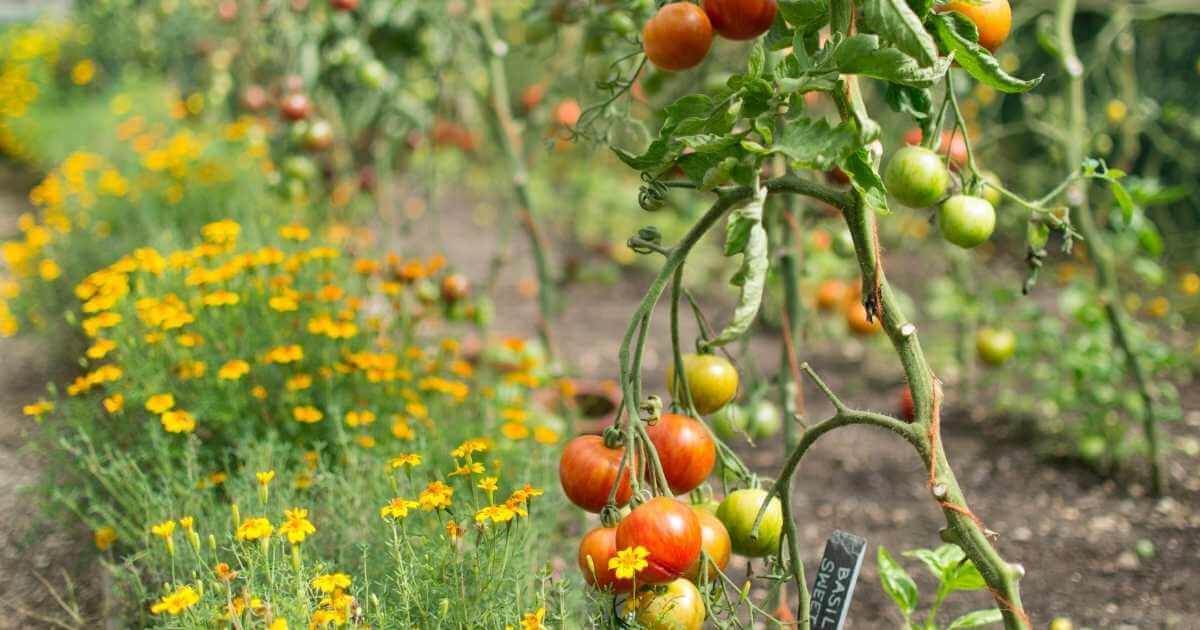
There is a lot of hocus-pocus gardening nonsense on the Internet. Because of that, one of the guiding principles of The Dallas Garden is to only present advice and education that is supported by science.
For example, when it comes to the concept of companion planting, there are lots of wild claims out there but few scientific studies to back those claims up. So, I rarely recommend the practice unless I have direct evidence to support it.
For that reason, when asked about the benefits of planting marigolds with tomatoes, I’ve always said, “Don’t get your hopes up.” But has the time come for me to change my tune? And could the benefits of marigolds for tomatoes mean larger benefits for our ecosystem?
The theory of companion planting and why we should take care with that term
The theory behind companion planting is that certain plants form beneficial relationships with other plants when grown in close proximity.
The reported benefits of companion planting include pest deterrence, disease resistance, and enhanced growth and productivity.
However, many scientists agree that the term “companion planting” is used too loosely – especially on the Internet – blurring the lines between actual science, pseudoscience, and the supernatural.
Linda Chalker-Scott, extension horticulturist and associate professor at Washington State University, makes it very clear that “companion planting” lore should not be confused with the research-based concepts of intercropping and plant association.
She asserts, “There is no scientific basis […] for any of the several lists that exist describing ‘traditional companion plants’. Like horoscopes, these lists may be fun to use, but they should not be perceived or promoted as scientifically valid any more than astrology. Furthermore, those of us who value the science behind our horticultural practices should avoid using this phrase for precisely the same reason.”
Newcastle study tests French marigolds against whiteflies
One plant association long considered to be merely companion planting lore is that of marigolds and tomatoes. For generations, gardeners reported fewer pest problems when marigolds were around, but the scientific support for the theory wasn’t available.
In 2019, scientists from Newcastle University’s School of Natural and Environmental Sciences set out to change that.
Knowing that gardeners were convinced of the marigold’s ability to ward off certain pests – specifically whiteflies – the Newcastle scientists sought to establish a scientific basis for growing French marigolds alongside tomato plants from the start of the growing season to protect tomatoes from whitefly infestation. They also wanted to know if the pest control effects of marigolds could be enhanced by the presence of other plants.
The study revealed that when French marigolds were grown next to tomatoes throughout the growing period, the development of a whitefly population was significantly slowed. However, when marigolds were added as an emergency treatment around tomatoes after a whitefly population was allowed to get quite high, it did little to reduce the existing whitefly population. The only emergency treatment found to be effective was the introduction of limonene dispensers.
Said more plainly: marigolds are most effective against whiteflies on tomatoes when both plants are grown together. They don’t help much when introduced after an infestation occurs.
What is limonene?
Limonene is a major chemical component of French marigolds and whiteflies have a negative response to the compound.
According to the Biomimicry Institute, limonene belongs to a group of chemical substances called volatile plant compounds (VPCs). VPCs are emitted by plants to send signals to other plants or to attract or repel insects. An insect’s antennae or other sensory organs detect the VPCs, just as a human nose detects many chemical compounds. VPCs can be isolated from a plant.
It’s not just marigolds that are effective
When the Newcastle scientists introduced whitefly-attracting plants around the tomato plants to test whether the marigold control could be enhanced, the “pull plants” did little to slow whiteflies. Interestingly though, when the marigold population was reduced and replaced by other non-hosts of whiteflies (basil, nasturtium, and Chinese cabbage) the whitefly population still diminished.
Because of this result, the scientists argue that their work supports the possibility of developing of a mixture of plants to intercrop with tomatoes that would create an ‘associational resistance’ against many major tomato pests.
They go on to suggest that such a mix, if it includes edible or ornamental species, could be economically viable for growers and provide numerous societal benefits such as reducing pesticide use, diversifying horticultural production, increasing the diversity of invertebrate fauna within agro-ecosystems, and increasing the diversity of produce on market shelves in a world increasingly dominated by fewer food types.

How to grow marigolds in North Texas
Marigolds are easy annuals to grow in our climate. They are widely available as transplants at local garden centers, and they are very easy to start by seed indoors.
Plant them after all chance of frost has passed (mid-to-late March) in an area with full sun and well-drained soil. (If you struggle with compacted clay soil, incorporate expanded shale to a depth of 6-8 inches before planting.)
Marigolds are not water hogs, but like most plants they will need at least one inch of water per week for maximum performance.
When plants start to lag in July, cut back by 1/3 to encourage a strong fall bloom and to maintain the plant’s overall shape. Deadheading spent blooms throughout the season will also promote longer bloom times.
French marigolds vs. African marigolds


There are two common types of marigolds: French and African (sometimes called American). African marigolds are the large, double-flowered, yellow and orange marigolds that are often grown as bedding plants.
French marigolds are smaller, bushier plants with single or double flowers in colors ranging from yellow to orange to rust red. They have a longer blooming season than African marigolds.
Both African and French marigolds contain limonene.
Sample tomato intercropping layout
Here is a sample layout of tomato intercropping in a raised bed using marigolds, basil, and nasturtium. All three of these plants – shown to repel whiteflies when planted together – will fit nicely around tomato plants without crowding them.

Summary
Thanks to the scientists at Newcastle, gardeners can now stand firm in their conviction that planting marigolds with tomatoes is an effective means of repelling certain pests. The fact that tomato plants are equally protected by adding basil, nasturtiums or Chinese cabbage into the mix is icing on the cake. How nice that we can have vegetable gardens that are both sustainable and beautiful!
It is important, however, that we start to move away from using the phrase “companion planting”. Instead, when we discuss the practice of growing plants together in order to reduce pesticide use and increase biodiversity let’s use the scientifically-recognized and scientifically-supported terms “intercropping” or “plant association”.
Do you plant marigolds with your tomatoes? Let me know in the comments below.
Further reading
Conboy NJA, McDaniel T, Ormerod A, George D, Gatehouse AMR, Wharton E, et al. (2019) Companion planting with French marigolds protects tomato plants from glasshouse whiteflies through the emission of airborne limonene. PLoS ONE 14(3): e0213071. https://doi.org/10.1371/journal.pone.0213071
Linda Chalker-Scott, Ph.D., Extension Horticulturist and Associate Professor, Puyallup Research and Extension Center, Washington State University, “The Myth of Companion Plantings”
“Limonene from marigolds repels whiteflies”, Biomimicry Institute
Resources
- Can Eating Tomatoes Help Prevent Weight Gain? New Study Says Yes - May 25, 2025
- New to Gardening? Join Our Step-by-Step Beginner Gardening Class - April 24, 2025
- Why “Intensive” Gardening is Not Good - March 9, 2025





I’m still going to use the term – it’s quaint and gets to the point – intercropping is a good term but gardening is not just about science, it’s an art to some and merely a hobby to others – it’s also an escape and a study of all life that interacts before our eyes whether we believe it or prove it or not. Science is important and quite essential but let’s not take the fun or romance out from language that’s been used for hundreds of years.